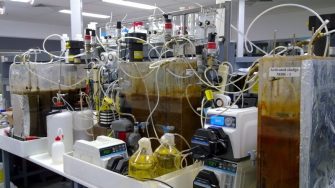

oagulant addition is used widely in both conventional and membrane-based water treatment as an essential aid to floc formation and is also recognized to assist greatly in reducing the extent of trans-membrane pressure (TMP) build-up in submerged membrane bioreactor treatment of wastewaters . Coagulant addition may also assist in removal of phosphorus in treatment of wastewaters and is also recognized to aid the dewatering of the highly gelatinous sludge that is typically produced in submerged membrane bioreactor wastewater treatment.
Despite the apparent advantages, there has been only limited investigation of the impact of coagulant choice and dosing conditions on nutrient removal, membrane fouling and excess sludge dewatering in SMBR treatment of wastewaters. One reason for the limited research undertaken to date in this area relates to the complexity of the SMBR system and the variety of reactions that can occur on addition of a coagulant to a membrane bioreactor.
Some of the unanswered questions are:
- Does the coagulant precipitate and, if so, is the major form an oxide or phosphate solid?
- Do these solids transform to more crystalline entities over time?
- If, rather, the coagulant initially forms dissolved complexes with the organic matter present, how stable are these complexes?
- If Fe(III) salts are added to the anoxic chamber, is iron reduced to Fe(II) species?
- On transport to the aerated chambers, does Fe(II) oxidise and, if so, what are the oxid...
- Research team
- Collaborators
- Funding body
- Publications
Beijing Origin Water Technology
Tsinghua University
Sydney Water
Water Research Australia
ARC Linkage Grant LP100100056
- Wang Y; Leslie GL; Waite TD, 2014, 'Impact of iron dosing of membrane bioreactors on membrane fouling', Chemical Engineering Journal, vol. 252, pp. 239 - 248, http://dx.doi.org/10.1016/j.cej.2014.04.106, opens in a new window
- Wang Y; Tng KH; Wu H; Leslie G; Waite TD, 2014, 'Removal of phosphorus from wastewaters using ferrous salts - A pilot scale membrane bioreactor study', Water Research, vol. 57, pp. 140 - 150, http://dx.doi.org/10.1016/j.watres.2014.03.029, opens in a new window
- Liu X; Wang Y; Waite TD; Leslie G, 2016, 'Fluid Structure Interaction analysis of lateral fibre movement in submerged membrane reactors', Journal of Membrane Science, vol. 504, pp. 240 - 250, http://dx.doi.org/10.1016/j.memsci.2015.12.056, opens in a new window
- Wu H; Ikeda-Ohno A; Wang Y; Waite TD, 2015, 'Iron and phosphorus speciation in Fe-conditioned membrane bioreactor activated sludge', Water Research, vol. 76, pp. 213 - 226, http://dx.doi.org/10.1016/j.watres.2015.02.020, opens in a new window
- Liu X; Wang Y; Waite TD; Leslie G, 2015, 'Numerical simulation of bubble induced shear inmembrane bioreactors: Effects of mixed liquor rheology and membrane configuration', Water Research, vol. 75, pp. 131 - 145, http://dx.doi.org/10.1016/j.watres.2015.02.009
- Zhang Z; Wang Y; Leslie GL; Waite TD, 2015, 'Effect of ferric and ferrous iron addition on phosphorus removal and fouling in submerged membrane bioreactors', Water Research, vol. 69, pp. 210 - 222, http://dx.doi.org/10.1016/j.watres.2014.11.011, opens in a new window
- Xin Y; Bligh MW; Kinsela AS; Wang Y; Waite D, 2015, 'Calcium-mediated polysaccharide gel formation and breakage: Impact on membrane foulant hydraulic properties', Journal of Membrane Science, vol. 475, pp. 395 - 405, http://dx.doi.org/10.1016/j.memsci.2014.10.033
- Zhang Z; Bligh MW; Wang Y; Leslie GL; Bustamante H; Waite TD, 2015, 'Cleaning strategies for iron-fouled membranes from submerged membrane bioreactor treatment of wastewaters', Journal of Membrane Science, vol. 475, pp. 9 - 21, http://dx.doi.org/10.1016/j.memsci.2014.09.003, opens in a new window



